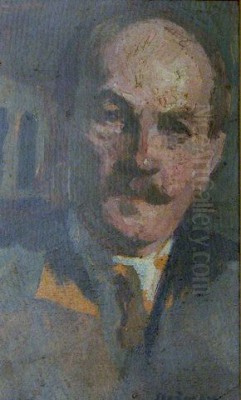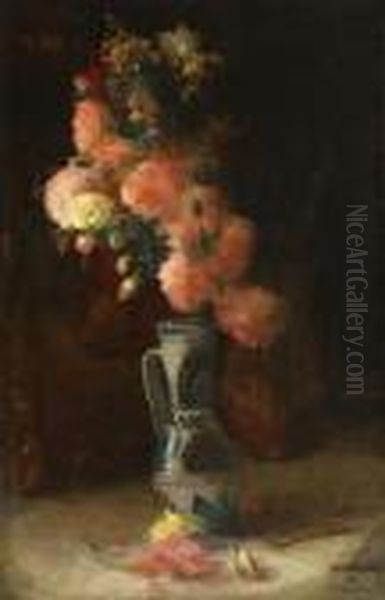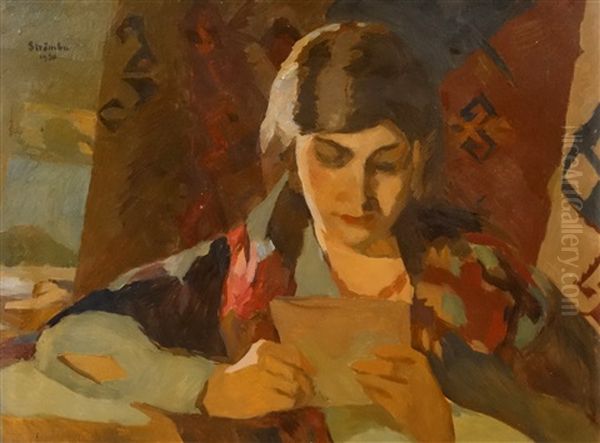
Ipolit Strâmbu (1871–1934) stands as a significant, albeit sometimes underappreciated, figure in the landscape of early 20th-century Romanian art. A painter, educator, and a founding member of influential artistic societies, Strâmbu played a crucial role during a period of profound transformation in Romanian culture, as artists sought to define a modern national identity while engaging with broader European artistic currents. His work, primarily rooted in an Impressionistic sensibility, captured the essence of Romanian rural life, landscapes, and the burgeoning modern spirit of his time.
Early Life and Artistic Formation
Born in 1871 in Mășărești, a village in the Vrancea county of Moldavia, Ipolit Strâmbu's early life was immersed in the traditional rhythms of Romanian rural existence. This upbringing would later profoundly inform his thematic choices as a painter. Seeking formal artistic training, he moved to Bucharest, the vibrant capital city that was rapidly becoming the epicenter of Romania's cultural and artistic development.
In Bucharest, Strâmbu enrolled at the prestigious Școala de Belle Arte (School of Fine Arts). Here, he studied under some of the most respected Romanian artists and pedagogues of the era. Among his influential teachers were Theodor Aman, a foundational figure in Romanian modern art known for his academic precision and historical paintings, and George Demetrescu Mirea, another key academic painter who also emphasized rigorous drawing and composition. The education at the School of Fine Arts, while traditional, provided Strâmbu with a solid technical foundation. He also reportedly studied under Theodor Spănu, further broadening his academic grounding.
To further refine his skills and expose himself to contemporary European art, Strâmbu, like many aspiring Romanian artists of his generation, traveled to Paris. The French capital was the undisputed center of the art world, and Strâmbu is noted to have attended the Académie Julian and possibly the École des Beaux-Arts. This period abroad was crucial, allowing him to absorb the influences of Impressionism and Post-Impressionism directly, witnessing firsthand the works of artists who were revolutionizing painting. This exposure would temper his academic training with a newfound appreciation for light, color, and spontaneous brushwork.
The Rise of Tinerimea Artistică

Upon his return to Romania, Ipolit Strâmbu became a key protagonist in the movement to modernize Romanian art. He was one of the founding members of "Tinerimea Artistică" (Artistic Youth), a society established in Bucharest in 1901. This group was a direct response to the perceived stagnation and conservatism of the official Salon and the prevailing academicism. Its members sought to revitalize Romanian art by promoting greater artistic freedom, embracing modern European trends, and fostering a distinctly Romanian artistic expression.
Alongside Strâmbu, other prominent founding members of Tinerimea Artistică included Ștefan Luchian, whose luminous depictions of flowers and landscapes made him a leading figure of Romanian Post-Impressionism; Constantin Artachino, known for his portraits and genre scenes; Nicolae Vermont, a painter of urban life and social themes; Gheorghe Petrașcu, who would later develop a powerful, impasto-laden style; Kimon Loghi, and Ștefan Popescu. The poet Ștefan Octavian Iosif was also a vocal supporter of the group, lending intellectual weight to their cause.
Tinerimea Artistică organized its own annual exhibitions, which quickly became important events in Bucharest's cultural life, offering an alternative to the official Salon. These exhibitions showcased a diversity of styles but were united by a commitment to innovation and a departure from rigid academic formulas. The society emphasized plein air painting, direct observation, and a brighter palette, reflecting the influence of Impressionism and Post-Impressionism. Strâmbu was an active participant in these exhibitions, contributing works that embodied the group's ideals.
Artistic Style and Thematic Focus
Ipolit Strâmbu's artistic style is most closely aligned with Impressionism, though it carries a distinctly Romanian character. He was particularly adept at capturing the fleeting effects of light and atmosphere, using a vibrant palette and broken brushstrokes to convey the immediacy of his visual experience. His subjects were often drawn from the Romanian countryside, a theme dear to many artists of his generation who sought to define a national identity through the depiction of its landscapes and people.
His paintings frequently feature scenes of peasant life, traditional customs, rural labor, and the serene beauty of the Romanian landscape. Works such as "Shalululă înflorită" (Flowering Shawl) exemplify his interest in traditional attire and the human figure within a natural setting. He painted portraits, genre scenes, and still lifes, often imbuing them with a gentle lyricism and a sense of intimacy. His figures are typically rendered with sympathy and an appreciation for their inherent dignity.

Strâmbu's engagement with light was central to his practice. He explored how light transformed colors and forms, whether in sun-dappled fields, the cool shade of an orchard, or the interior of a peasant home. While some critics of his time occasionally pointed to a perceived lack of complete "harmony" or "technical sensitivity" in certain works, this might also be interpreted as a reflection of his experimental approach and his desire to break free from overly polished academic finishes. His commitment was more to capturing the truth of his perception than to adhering to conventional notions of beauty.
Representative Works
Several of Ipolit Strâmbu's paintings are frequently cited as representative of his oeuvre, showcasing his stylistic tendencies and thematic preoccupations.
"Trandafiri" (Roses), painted in 1930, is a vibrant still life that demonstrates his skill in rendering the delicate textures and rich colors of flowers. The play of light on the petals and leaves, and the overall freshness of the composition, are characteristic of his Impressionistic approach.
"Lectură" (Reading), from 1929, likely depicts an intimate interior scene, a common genre that allowed artists to explore light effects within a contained space and to capture quiet moments of daily life. Such works often highlight the peaceful, contemplative aspects of domesticity.
"Canceu de gărofițe" (Pot of Carnations), also from 1930, is another example of his engagement with floral still lifes. These subjects provided ample opportunity for color experimentation and the study of light. The humble carnation, a common garden flower, also speaks to his connection with everyday beauty.
"Parfum de primăvară" (Scent of Spring), dated 1925, evokes the sensory experience of the season. One can imagine a landscape or garden scene bathed in the soft light of spring, with fresh greens and blossoming flowers, rendered with Strâmbu's characteristic sensitivity to atmosphere.
"Femeie cu umbrelă" (Woman with Umbrella), from 1927, is a classic Impressionist motif. The umbrella itself acts as a device to modulate light and shadow on the figure, allowing for a nuanced play of colors and tones. This subject was popular among French Impressionists like Monet and Renoir, and Strâmbu’s interpretation would have placed him within this broader European tradition.
Another notable work, "Women Embroidering in the Garden" (1914), captures a tranquil scene of traditional female activity. The painting likely focuses on the interplay of figures in a sunlit garden, the textures of their clothing, and the concentrated effort of their craft, all rendered with his typical attention to light and color.
Educator and Advocate
Beyond his own artistic production, Ipolit Strâmbu made significant contributions as an art educator. He taught at the School of Fine Arts in Bucharest, the very institution where he had received his initial training. In this role, he influenced a new generation of Romanian artists, passing on both technical skills and an appreciation for modern artistic principles. He is also credited with authoring a manual on painting, which would have served as a valuable resource for students.
Strâmbu was also recognized as a supporter of women artists in Romania, a particularly important role in an era when female artists often faced significant barriers to professional recognition. He is known to have collaborated with and supported prominent women artists such as Cecilia Cuțescu-Storck, a pioneering figure in Romanian art who co-founded the "Asociația Femeilor Pictore și Sculptore din România" (Association of Women Painters and Sculptors in Romania) and was the first female professor at an art academy in Europe. His advocacy contributed to a more inclusive artistic environment. His association with G. D. Mirea, his former teacher, also suggests a continued engagement with the academic art community, even as he championed modernism.
Interactions and Artistic Milieu
Ipolit Strâmbu was an active participant in the Romanian art scene, and his career was interwoven with those of many other prominent artists. His involvement with Tinerimea Artistică placed him at the heart of a dynamic network. His relationship with Nicolae Vermont, a fellow founder, was one of shared ideals and collaborative effort in challenging the artistic status quo. The support of figures like the poet Ștefan Octavian Iosif for Tinerimea Artistică highlights the interdisciplinary connections within Romania's cultural renaissance.
His time in Paris also brought him into contact with other artists. He is noted to have interacted with Petre Petrașcu, the brother of Gheorghe Petrașcu, who was also part of the Parisian artistic ferment. Such interactions were vital for the exchange of ideas and the dissemination of new artistic trends back to Romania.
The artistic landscape of Romania during Strâmbu's active years was rich and varied. Besides his colleagues in Tinerimea Artistică, other major figures were shaping Romanian art. Nicolae Grigorescu, the "father" of modern Romanian painting, and Ion Andreescu had already laid the groundwork for Impressionism in Romania. Contemporaries like Theodor Pallady, with his refined Post-Impressionist style influenced by Matisse; Nicolae Tonitza, celebrated for his poignant portraits of children and his social commentary; Camil Ressu, known for his strong drawing and monumental figures; and Jean Alexandru Steriadi, a chronicler of urban life and a subtle portraitist, all contributed to the vibrant artistic dialogue of the period. Even the sculptor Constantin Brâncuși, though he primarily worked abroad, emerged from this same period of national artistic awakening. Samuel Mützner was another contemporary known for his Luminist approach.
Critical Reception and Legacy
Ipolit Strâmbu's work was generally well-received during his lifetime, particularly within the context of Tinerimea Artistică's exhibitions. He was recognized as a skilled painter with a genuine connection to Romanian themes and a modern sensibility. The criticism that his work sometimes lacked "harmony" or "technical sensitivity" might reflect the evolving tastes of the time, as audiences and critics grappled with the departure from polished academic finishes towards the more expressive and subjective approaches of modern art.
His legacy lies in several key areas. Firstly, his paintings themselves offer a valuable visual record of Romanian life and landscape at the turn of the 20th century, rendered with an Impressionistic vibrancy. Secondly, his role as a co-founder of Tinerimea Artistică was crucial in challenging artistic conservatism and paving the way for modernism in Romania. This society provided a vital platform for artists seeking new forms of expression. Thirdly, his work as an educator helped to shape the next generation of Romanian artists. Finally, his support for women artists contributed to a more equitable and diverse art world.
While perhaps not as internationally renowned as some of his contemporaries like Brâncuși, or as nationally iconic as Grigorescu or Luchian, Ipolit Strâmbu remains an important figure. His active participation in official Salons in Bucharest, particularly noted in the period between 1933 and 1946 (though this likely refers to the continued exhibition of his works or the influence of movements he was part of, given his death in 1934), underscores his sustained presence in the Romanian art world.
Conclusion: An Enduring Contribution
Ipolit Strâmbu's career spanned a period of critical transformation in Romanian art and society. From his formative years in rural Moldavia and academic training in Bucharest and Paris, to his pivotal role in founding Tinerimea Artistică and his contributions as a painter and educator, Strâmbu dedicated his life to the advancement of Romanian art. He successfully navigated the path between national traditions and modern European influences, creating a body of work that is both authentically Romanian and reflective of broader artistic currents.
His paintings, characterized by their luminous color, sensitivity to light, and affectionate portrayal of Romanian life, continue to resonate. As a champion of artistic renewal and an advocate for a more inclusive art world, Ipolit Strâmbu's contributions extend beyond his canvases. He helped to shape the very infrastructure and ethos of modern Romanian art, leaving an indelible mark on its history. His work merits continued study and appreciation as an integral part of Romania's rich artistic heritage.